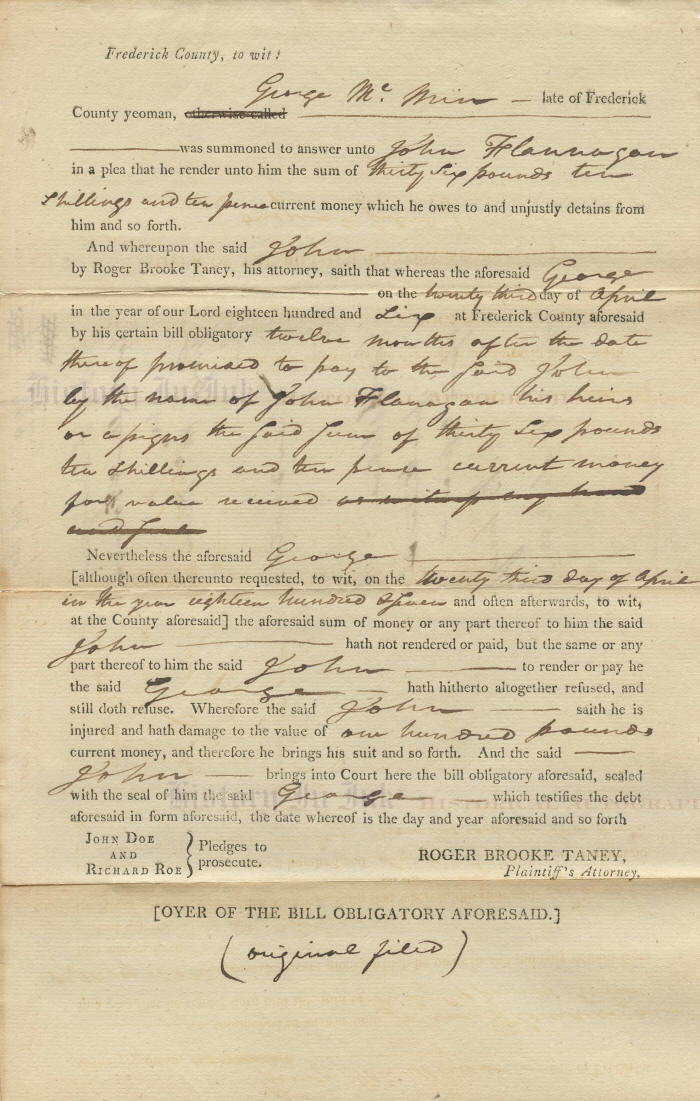1906402
Roger B. Taney
Scroll down to see images of the item below the description
As a young lawyer, Taney files suit to collect a debt owed to his client
Roger Brooke Taney, 1777–1864. Secretary of the Treasury, 1833–1834; Chief Justice of the United States, 1836–1864. Partially printed autograph document signed, R. B. Taney, and signed in print, roger brooke taney, two pages (front aand back), 7½” x 12½”, ca. 1807. With accompanying original promissory note.
Taney, while a young lawyer, files a lawsuit in Frederick County, Maryland, to collect a debt due his client on a promissory note. Taney asserts that the maker of the note, George McMin, had failed to pay his client, John Flannagan, the sum of £36.10.10—about $4,700 today. Taney has filled out the partially printed document, a form printed with his signature that he evidently used in collection cases. In full (the parts in Taney’s hand are in blue italics):
Frederick County, to wit:
George McMin – late of Frederick County yeoman, was summoned to answer unto John Flannagan in a plea that he render unto him the sum of Thirty Six pounds ten shillings and ten pence current money which he owes to and unjustly detains from him and so forth.
And whereupon the said John by Roger Brooke Taney, his attorney, saith that whereas the aforesaid George in the year of our Lord eighteen hundred and six at Frederick County aforesaid by his certain bill obligatory twelve months after the date thereof promised to pay to the said John by the name of John Flanagan his heirs or assigns the said sum of thirty six pounds ten shillings and ten pence current money for value received [Taney strikes out a handwritten reference to interest]
Nevertheless the aforesaid George [although often thereunto requested, to wit, on the twenty third day of April in the year eighteen hundred & seven and often afterwards, to wit, at the County aforesaid] the aforesaid sum of money or any part thereof to him the said John hath not rendered or paid, but the same or any part thereof to him the said John to render or pay he the said George hath hitherto altogether refused, and still doth refuse. Wherefore the said John saith he is injured and hath damage to the value of one hundred pounds current money, and therefore he brings his suit and so forth. And the said John brings into Court here the bill obligatory aforesaid, sealed with the seal of him the said George which testifies the debt aforesaid in form aforesaid, the date whereof is the day and year aforesaid and so forth[.]
John Doe )
and ) Pledges to ROGER BROOKE TANEY,
Richard Roe ) prosecute. Plaintiff's Attorney.
[ OYER OF THE BILL OBLIGATORY AFORESAID. ]
( original filed )
On the back, vertically between two folds, on the outside of the folded document, Taney has written the case caption and instructions to William Ritchie, the Frederick County clerk:
John Flanagan
for Keller & Forman
vs.
George McMin
has 2 notes
Mr. Ritchie
file these and
issue capias—
R. B. Taney
Interestingly, Taney has sued for damages of £100 for the payment of a promissory note for just over a third of that. The document does not explain how the plaintiff’s damages could amount to that much. Taney has stricken out language that he initially wrote that appears to relate to interest on the loan, so the difference could not amount to unpaid interest. The original promissory note, which accompanies this document, says nothing about interest, although note does not say how much Flanagann had actually loaned McMin, so the total amount of the note could have included interest, since the note was payable a year from its date.
Taney is perhaps best known as the author of the Supreme Court’s controversial and ill-fated decision in Dred Scott v. Sandford, 60 U.S. 393 (1857). In an opinion written by Taney, the Supreme Court held that African Americans were not citizens of the United States and thus lacked standing to sue for their freedom in federal court. The Court also held that Congress could not forbid slavery in the territories and that the Missouri Compromise therefore was unconstitutional. Although the Kansas-Nebraska Act had already gutted the Missouri Compromise, some historians argue that the Dred Scott decision led directly to the Civil War. It has been excoriated as the Supreme Court’s all-time worst decision.
Taney personally thought slavery evil, however, although as a Maryland native he grew up in a slaveholding tobacco plantation family. He freed the slaves whom he inherited from his father, and he provided lifetime monthly pensions for the older freed slaves who were unable to work. In 1819, defending a minister who was arrested for criticizing slavery, Taney called slavery “a blot on our national character.” Yet he believed that slavery was a problem that had to be resolved gradually and principally by the affected states in which it existed.
Taney became Chief Justice after the Senate had rejected his nomination for both Secretary of the Treasury and Associate Justice of the Supreme Court. As Attorney General, Taney was President Andrew Jackson’s legal advisor during Jackson’s crusade against the Second Bank of the United States and wrote much of Jackson’s message vetoing the act to recharter the bank. After Jackson was reelected in 1832, Taney advised him to withdraw the government’s funds from the bank. When two successive Secretaries of the Treasury, Louis McLane and then William J. Duane, refused to do so, Jackson made Taney the Secretary of the Treasury by a recess appointment. Taney did Jackson’s bidding and transferred the funds to various commercial banks. As punishment, the Senate refused to confirm Taney as secretary. In 1835, Jackson nominated Taney to replace Justice Gabriel Duvall as an Associate Justice of the Supreme Court, but the Senate again balked, postponing the confirmation vote indefinitely. Less than a year later, following the death of Chief Justice John Marshall, Jackson nominated Taney for Chief Justice, and ultimately Taney was confirmed.
Taney graduated first in his class at Dickinson College. He then apprenticed three years with an Annapolis lawyer before being admitted to the bar in 1799. He quickly distinguished himself as one of Maryland’s most promising young lawyers.
Initially a Federalist, Taney split with the party leadership over the War of 1812, which he supported. Ultimately he gained control of the Maryland Federalists, and in 1816 he was elected to a five-year term in the state senate. He reentered private law practice in 1821 and, after building a large practice, moved from Frederick to Baltimore in 1823. The next year, he permanently abandoned the Federalists to support Jackson. Jackson named him Attorney General in 1831.
This document is in fine condition. Taney’s handwriting and signature are bold. There are fold splits of ½” on the left edges of the top two horizontal folds and a split of 1” at the left edge of the third, all of which could be repaired without affecting the text of the document or Taney’s signature. The original promissory note signed by McMin and apparently also by his wife is irregularly trimmed but also is otherwise in fine condition.
Unframed.










